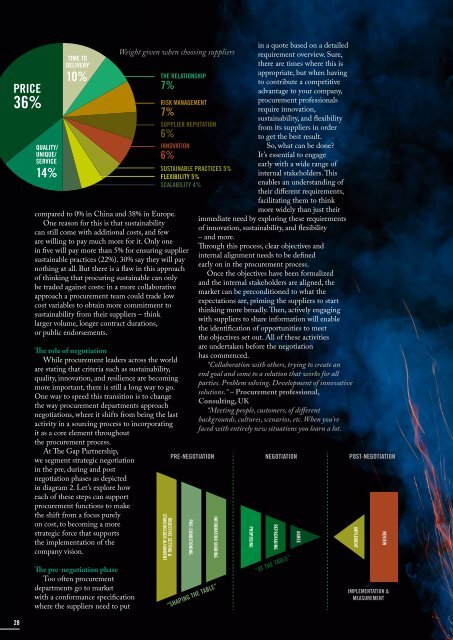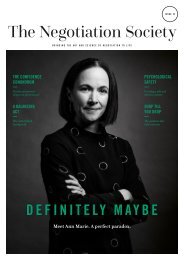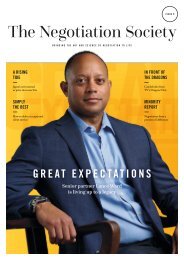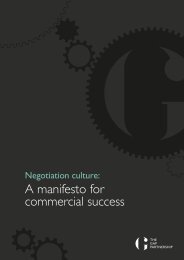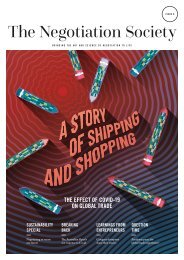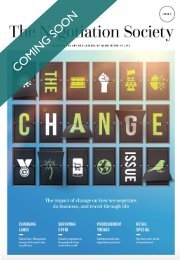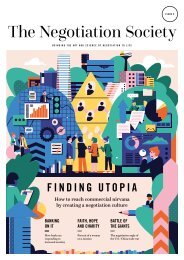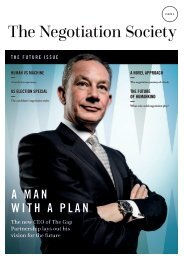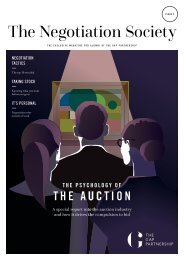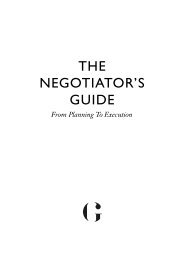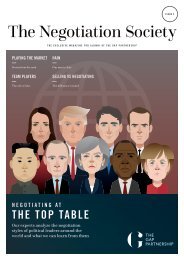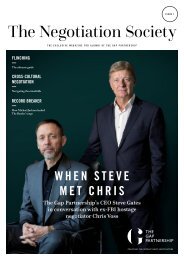The-Negotiation-Society-Magazine-The-Change-Issue
You also want an ePaper? Increase the reach of your titles
YUMPU automatically turns print PDFs into web optimized ePapers that Google loves.
PRICE<br />
36%<br />
28<br />
QUALITY/<br />
UNIQUE/<br />
SERVICE<br />
14%<br />
TIME TO<br />
DELIVERY<br />
10%<br />
Weight given when choosing suppliers<br />
THE RELATIONSHIP<br />
7%<br />
RISK MANAGEMENT<br />
7%<br />
SUPPLIER REPUTATION<br />
6%<br />
INNOVATION<br />
6%<br />
compared to 0% in China and 38% in Europe.<br />
One reason for this is that sustainability<br />
can still come with additional costs, and few<br />
are willing to pay much more for it. Only one<br />
in five will pay more than 5% for ensuring supplier<br />
sustainable practices (22%). 30% say they will pay<br />
nothing at all. But there is a flaw in this approach<br />
of thinking that procuring sustainable can only<br />
be traded against costs: in a more collaborative<br />
approach a procurement team could trade low<br />
cost variables to obtain more commitment to<br />
sustainability from their suppliers – think<br />
larger volume, longer contract durations,<br />
or public endorsements.<br />
<strong>The</strong> role of negotiation<br />
While procurement leaders across the world<br />
are stating that criteria such as sustainability,<br />
quality, innovation, and resilience are becoming<br />
more important, there is still a long way to go.<br />
One way to speed this transition is to change<br />
the way procurement departments approach<br />
negotiations, where it shifts from being the last<br />
activity in a sourcing process to incorporating<br />
it as a core element throughout<br />
the procurement process.<br />
At <strong>The</strong> Gap Partnership,<br />
we segment strategic negotiation<br />
in the pre, during and post<br />
negotiation phases as depicted<br />
in diagram 2. Let’s explore how<br />
each of these steps can support<br />
procurement functions to make<br />
the shift from a focus purely<br />
on cost, to becoming a more<br />
strategic force that supports<br />
the implementation of the<br />
company vision.<br />
<strong>The</strong> pre-negotiation phase<br />
Too often procurement<br />
departments go to market<br />
with a conformance specification<br />
where the suppliers need to put<br />
SUSTAINABLE PRACTICES 5%<br />
FLEXIBILITY 5%<br />
SCALABILITY 4%<br />
OBJECTIVE SETTING &<br />
STAKEHOLDER ALIGNMENT<br />
PRE-NEGOTIATION NEGOTIATION POST-NEGOTIATION<br />
PRE-CONDITIONING<br />
in a quote based on a detailed<br />
requirement overview. Sure,<br />
there are times where this is<br />
appropriate, but when having<br />
to contribute a competitive<br />
advantage to your company,<br />
procurement professionals<br />
require innovation,<br />
sustainability, and flexibility<br />
from its suppliers in order<br />
to get the best result.<br />
So, what can be done?<br />
It’s essential to engage<br />
early with a wide range of<br />
internal stakeholders. This<br />
enables an understanding of<br />
their different requirements,<br />
facilitating them to think<br />
more widely than just their<br />
immediate need by exploring these requirements<br />
of innovation, sustainability, and flexibility<br />
– and more.<br />
Through this process, clear objectives and<br />
internal alignment needs to be defined<br />
early on in the procurement process.<br />
Once the objectives have been formalized<br />
and the internal stakeholders are aligned, the<br />
market can be preconditioned to what the<br />
expectations are, priming the suppliers to start<br />
thinking more broadly. <strong>The</strong>n, actively engaging<br />
with suppliers to share information will enable<br />
the identification of opportunities to meet<br />
the objectives set out. All of these activities<br />
are undertaken before the negotiation<br />
has commenced.<br />
“Collaboration with others, trying to create an<br />
end goal and come to a solution that works for all<br />
parties. Problem solving. Development of innovative<br />
solutions.” – Procurement professional,<br />
Consulting, UK<br />
“Meeting people, customers, of different<br />
backgrounds, cultures, scenarios, etc. When you're<br />
faced with entirely new situations you learn a lot.<br />
INFORMATION SHARING<br />
PROPOSING<br />
REPACKAGING<br />
“SHAPING THE TABLE” “AT THE TABLE”<br />
AGREE<br />
IMPLEMENT<br />
REVIEW<br />
IMPLEMENTATION &<br />
MEASUREMENT


